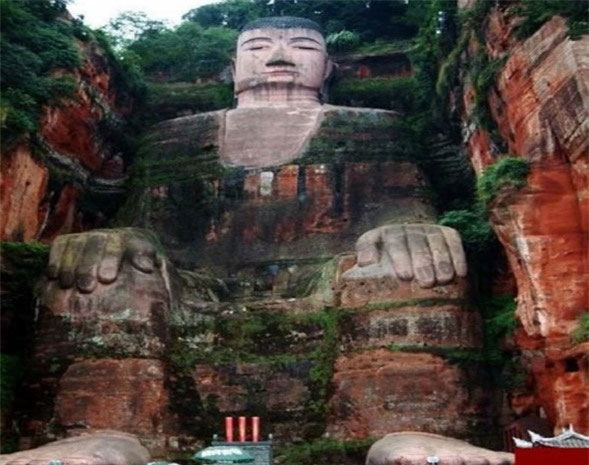The giant Buddha statue frequently appears “dirty-faced,” causing headaches for heritage conservation experts.
The Giant Buddha statue in Leshan, a famous historical site located in Leshan City, Sichuan Province, has often been seen with a “dirty face” in recent years, prompting cultural heritage conservation experts to take action. To thoroughly address the damage to the appearance of this large cultural monument, which has a history of over 1,000 years, the Sichuan Provincial Cultural Heritage Administration organized a gathering of several renowned cultural heritage conservation experts from China to consult on the Leshan Giant Buddha and propose the first “treatment method.”
According to The Paper, the Leshan Giant Buddha in Sichuan is the largest seated Buddha statue carved from stone that remains in the world, standing over 70 meters tall and boasting a history of more than 1,000 years. The statue was carved into a red sandstone cliff at the confluence of three rivers: the Dadu River, the Qingyi River, and the Min River. However, the red sandstone mountain has suffered severe weathering, and the surface of some rock blocks is clearly made of silt, which can easily crumble when lightly scraped with a finger.
On January 8, the Sichuan Provincial Cultural Heritage Administration held a symposium on cave protection, attended by many renowned experts from across the country. The symposium, held in Leshan City, Sichuan Province, addressed the ongoing issues of the Leshan Giant Buddha appearing “dirty-faced” and “weeping” and proposed a “water treatment” remedy.

Buddha statue expressing sorrow
Xia Xiaolin, Secretary of the Party Committee of the Leshan Giant Buddha Scenic Area, stated at the symposium that due to factors such as humid climate, heavy rainfall, and the nature of the rock, the Leshan Giant Buddha has faced severe issues over a long period, including water damage, biological growth, weathering, and the deterioration of repair layers.
These “ailments” appear to tourists as a “dirty face,” “crying Buddha,” “old grass,” “cracks,” and more. The most recent large-scale repair was completed three years ago.
According to sources, experts from the Chinese Cultural Heritage Research Institute, Dunhuang Research Institute, Sichuan Provincial Archaeology and Cultural Heritage Institute, and other organizations have agreed that there are many “diseases” affecting the Leshan Giant Buddha, with the most significant “root cause” being flooding. Since 1914, the Leshan Giant Buddha has undergone seven large-scale surface repairs, but none have addressed the issues stemming from the “root cause.”
Qian Zhangfa, Director of Cultural Heritage Protection and Restoration at the Chinese Cultural Heritage Academy, pointed out: “Where are the water issues and internal cracks? What materials should be used for restoration to improve weather resistance? Should a large Buddha platform be constructed for protection? What are the limits on tourist capacity? There needs to be a systematic plan and phased implementation; this is a comprehensive task that requires long-term research by a team of scientific experts.”
Wang Yi, Director of the Sichuan Provincial Cultural Heritage Administration, stated that to tackle the series of “prescriptions,” it is essential to rely on the Sichuan Research Institute for the Protection of Temples and the Leshan Giant Buddha. The research institute will collaborate deeply with domestic and international scientific research agencies to comprehensively and systematically protect the Leshan Giant Buddha, conduct interdisciplinary studies, strengthen team structure, and implement beneficial protective projects.


















































